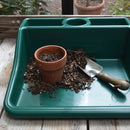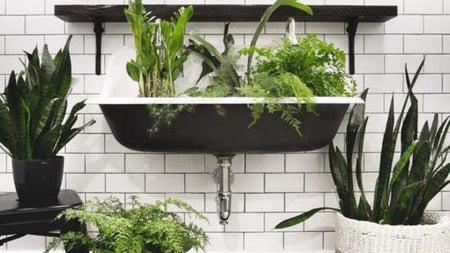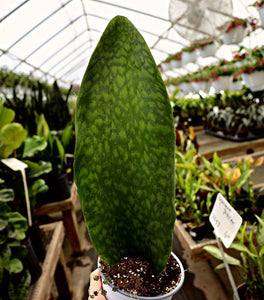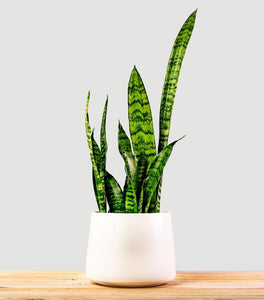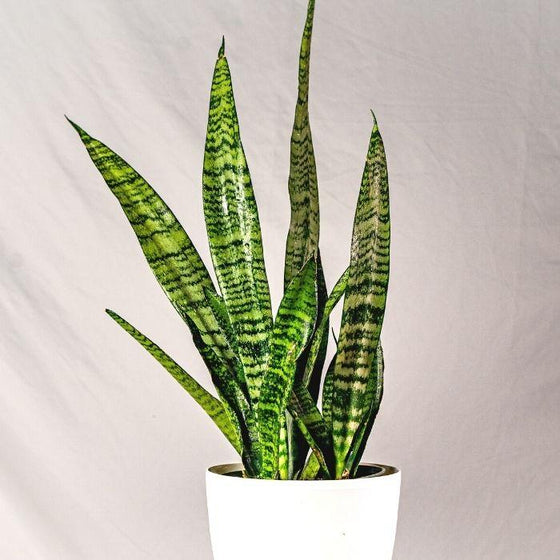
Images Depicted Range in Maturity & Container Size
Pots & Decorations Not Included Unless Otherwise Stated
Black Coral Snake Plant: Inky, Architectural Foliage for Effortless Style
Dark, Sword-Shaped Leaves with Silver Waves
The Black Coral Snake Plant is a striking selection of Dracaena trifasciata (formerly Sansevieria), known for its tall, sword-like leaves in deep, almost charcoal green, etched with wavy, silver-green horizontal bands. The foliage grows upright in dense clumps, creating a bold, architectural silhouette that looks just as sharp in a modern loft as it does in a cozy home office. This is a plant that feels sculptural and intentional even when you’ve barely lifted a finger.
Upright, Clumping, and Space-Efficient
Indoors, Black Coral Snake Plant typically matures around 3–4 feet tall with a spread of about 18–24 inches, forming a tight clump of vertical leaves. New shoots emerge from underground rhizomes, gradually thickening the plant rather than sprawling outward, so it occupies a relatively small footprint for the height and drama it delivers. Growth is slow to moderate, which means it retains its shape for years without constant repotting or pruning—perfect for hallways, corners, and areas where you want a tall presence that stays in place.
Flexible Light and Infrequent Watering
One of the biggest perks of Black Coral is its forgiving nature with light. It handles anything from low indoor light to bright, indirect sun, and even some direct sun if it’s acclimated gradually, though intense afternoon rays can scorch the leaves. It generally grows faster and colors more intensely in brighter light, but it remains presentable in dimmer corners where many plants fail to thrive. Plant it in a gritty, well-draining mix—think high-quality potting soil combined with sand, perlite, or cactus mix—so excess water never lingers around the roots.
Watering is where this plant really spoils you. As a succulent-type houseplant, Black Coral prefers its soil to dry almost completely between waterings and will tolerate a bit of benign neglect. In most indoor settings, that means watering roughly every 2–6 weeks, depending on pot size, light, and temperature—less in low light or winter, a bit more in bright, warm rooms. Overwatering is the main way to get in trouble; consistently soggy soil can lead to root rot and fungal issues near the base, so err on the dry side and always use a pot with drainage holes.
Nearly No-Fail Focal Plant for Home or Office
Think of Black Coral Snake Plant as your go-to vertical accent in the “indoor landscape.” Its tall, narrow form slides neatly between furniture, along hallway walls, beside entry tables, or in corners that need height without clutter. Designers love it for offices, lobbies, and bedrooms because it reads clean and modern while tolerating low light and inconsistent care. Like other snake plants, it’s often noted for its air-purifying qualities and long lifespan, making it a brilliant, low-effort investment piece for your space. Do keep in mind that, like other Dracaena trifasciata varieties, it is considered mildly toxic to pets if chewed, so place it where curious cats and dogs aren’t likely to snack on the leaves.
Also known as a Mother-in-Law's Tongue, this plant is on our list for Top 5 Houseplants for Beginners. Botanically referred to as 'Sansevieria Trifasciata Black Coral,' these low-maintenance houseplants boast waxy, sword-like foliage that makes for a perfect vertical element to a space.

| Hardiness Zone: | 9-11 |
|---|---|
| Mature Height: | About 3–4 ft tall |
| Mature Width: | 1.5–2 ft wide indoors |
| Classification: | Evergreen succulent houseplant; tropical |
| Bloom Time/Color | Infrequent; occasional white to pale green fragrant flower spikes on mature plants |
| Sunlight: | Low to bright indirect light; tolerates some sun with acclimation |
| Soil Condition: | Gritty, sharply draining cactus/succulent mix or potting soil with sand/perlite |
| Water Require: | Allow soil to dry almost completely; water every ~2–6 weeks depending on conditions |
| Uses: | Low-maintenance focal plant for homes, offices, and commercial spaces |
How to Care for Black Coral Snake Plant (Dracaena trifasciata ‘Black Coral’)
Be sure to read our planting and care instructions to ensure a healthy and happy Black Coral Snake Plant for years to come!

How should I plant Black Coral Snake Plant?
Start with a sturdy container that has drainage holes and isn’t overly large—snake plants actually prefer to be somewhat snug in their pots. Fill the bottom with a gritty, well-draining mix made from quality potting soil blended with cactus mix, sand, or perlite so excess moisture runs through easily. Gently slide the plant from its nursery pot, loosen any circling roots, and set the root mass so the top sits just at or slightly above the surrounding soil line. Backfill around the roots, lightly firming to eliminate air pockets without compressing the mix. After planting, water thoroughly once to settle the mix, then let the pot drain completely before returning it to a saucer or cachepot. Place your Black Coral Snake Plant in low to bright indirect light—anything from a few feet back from a bright window to a well-lit office corner usually works, as long as it’s not in harsh, focused midday sun right against hot glass. In brighter light, you’ll see stronger growth and more distinct banding; in lower light, growth slows but the plant still holds its bold, upright form.
How often should I water Black Coral Snake Plant after planting?
Once planted, resist the urge to water frequently—Black Coral is built for drought tolerance. Allow the soil to dry almost completely from top to bottom between waterings, then water slowly and deeply until moisture runs out of the drainage holes. In most indoor homes and offices, that can translate to watering roughly every 2–6 weeks, depending on pot size, temperature, and how much light it receives. Plants in bright, warm spots will use water faster; those in lower light will need far less frequent watering. During fall and winter, when growth naturally slows and indoor light is weaker, stretch out watering intervals even further—snake plants are far more forgiving of underwatering than of sitting in wet soil. Watch the leaves for clues: slightly wrinkled or inward-curving leaves suggest it’s time for a drink; mushy, yellowing, or collapsing foliage points to overwatering and potential root rot. Always discard any water that collects in decorative sleeves or saucers so roots aren’t left standing in it.
When should I fertilize Black Coral Snake Plant?
Because Black Coral Snake Plant is a slow to moderate grower, it doesn’t need heavy feeding. During the active growing season—typically spring through early fall—you can apply a balanced, water-soluble houseplant or succulent fertilizer at half strength once every 1–2 months. Always fertilize onto already-moist soil, not bone-dry mix, to avoid burning roots with concentrated salts. This light feeding schedule is enough to support healthy foliage color and steady, upright growth without pushing soft, weak tissue. If you prefer a minimal-input routine, a single spring application of a slow-release granular fertilizer formulated for houseplants or succulents is usually sufficient for the year. Snake plants in lower light or smaller pots may not need additional feeding beyond that. Avoid fertilizing in late fall and winter when the plant is resting; unused nutrients can accumulate in the soil and contribute to tip burn or root stress, especially when combined with less frequent watering.

When and how should I prune Black Coral Snake Plant?
Black Coral rarely needs traditional pruning; most of the work is simple grooming. Use clean, sharp pruners to remove any damaged, yellowed, or badly scarred leaves by cutting them off cleanly at the soil line. If a leaf is only slightly blemished but otherwise sturdy, you can trim just the damaged portion with a neat, angled cut, although cut edges may dry slightly over time. Regularly wiping dust from the tall leaves with a soft, barely damp cloth helps them look glossy and allows them to photosynthesize efficiently. If your plant becomes very crowded or you’d like more, you can divide the clump when repotting. Gently remove the plant from its container, separate sections of rhizome that each have several healthy leaves and roots, and pot them up individually in fresh, well-draining mix. Division is best done in spring, giving each new section a full growing season to establish. Because Black Coral is slow to change shape, even infrequent grooming and occasional division will keep it looking clean, upright, and intentional for many years.










